#project hilla
Text

[𝕋𝕦𝕝𝕚𝕜𝕜𝕠]
“They dance among the stars and hold the keys to magical powers.”
In Finnish auroras are known as “revontulet” which roughly translates to “fox fires”, a name delivered from mythological creature known as Tulikk or Tulikettu (i.e. Firefox, tuli = fire, kettu = fox). According to folklore, the Tulikko lives in the woods and is rarely seen. Tulikko is black during the days but glimmers like a fire during the nights. The leather (or fur) of a Tulikko is immensely valuable, since it can illuminate without burning. It is said that catching one could make the hunter rich beyond measure. Auroras are the result of the Tulikko’s tail light trail.
—
I can never think about the word “aurora borealis” without thinking about that one The Simpsons episode…
ততততততততততততততততততততত
All links @
🍆 Vinders.gay 🍆
Support me @
🍆 Kofi - ko-fi.com/vinders (digital downloads)
🍆 Patreon - patreon.com/vinders
🍆 Etsy - etsy.com/shop/vindersart (posters, stickers & postcards)
Commission info
🍆 vindersart.carrd.co 🍆
54 notes
·
View notes
Text
LOOK AT THIS PIC MY DAD SENT ME

AAAAAAAA
#my post#in case someone didnt know I made that cottage for an art project in summer and moved it to my frontyard when it was over#and my cats have taken over it#hilla the cat#tuisku the cat#catblr#cats of tumblr#cats
4 notes
·
View notes
Photo

Bernd and Hilla Becher. Cooling Tower, Zeche Mont Cenis, Herne, Ruhr Region, Germany. 1965
Follow my new AI-related project «Collective memories»
#BW#Black and White#Preto e Branco#Noir et Blanc#黒と白#Schwarzweiß#retro#vintage#Bernd Becher#Hilda Becher#Cooling tower#Zeche Mont Cenis#Herne#Ruhr#germany#Alemanha#1965#1960s#60s#Architecture#Arquitetura#Architektur#建築#アーキテクチャ#buildings#bâtiments#Gebäude#edifícios#建物#industrial architecture
77 notes
·
View notes
Photo

THE FRIDAY PIC is “Comparative Juxtaposition, Nine Objects, Each with a Different Function” (1961–72), from the stunning survey of Bernd and Hilla Becher at the Metropolitan Museum of Art in New York. I just reviewed it for the New York Times, making the argument that the Bechers’ orderly inventories of industrial life actually point to the fractures of an industrial order that was fading in their day. (Read on for the full text of my Times piece, pasted at the end of this post.)
Newspaper writing didn’t give me room to touch on something else that struck me about the Bechers’ work. I believe, as is often claimed, that it echoes the great earlier “inventory” compiled by the Bechers’ predecessor August Sander in his "People of the 20th Century,” mostly worked on between the two world wars. But that echo doesn’t come from a shared interest in accurate inventories and orderings, which is the usual claim about these two bodies of work, but from the way both Sander and the Bechers reveal failures in ordering structures.
Just as the Bechers’ orderly photos wake us up to industrial order at the moment of its collapse, so Sander was pretending to catalog the German people when the smart thinkers of his era (e.g., John Dewey) were calling the whole idea of a “people” into question. As I argued some years ago, Sander’s supposed catalog of Germans quite deliberately fails to be a true catalog: He happily used the same friend of his to play several roles in his supposed inventory of distinct types; the categories he sorts people into can be arbitrary to the point of absurdity; his photos can be entirely unrevealing as to who their sitters are and what they do. Sander’s project, I once claimed, “implies a full repudiation of the kind of social sorting that led to the Nazis. It doesn’t merely ‘humanize’ that sorting, as the standard Sander cliche proclaims.” I’d say that the Bechers’ photos, following on from Sander’s example, imply a similar resistance to the industrial order that they’ve often been thought to embody.
(Image courtesty Estate Bernd & Hilla Becher, represented by Max Becher; via The Metropolitan Museum of Art)
And here’s my full Times story on the Bechers:
Photography’s Delightful Obsessives
The Met surveys Bernd and Hilla Becher, who turned Machine Age monuments into alluring collectibles.
By Blake Gopnik
July 28, 2022
One wall is gridded up with photos of industrial cooling towers, portrayed in wildly detailed black-and-white.
Another gives us 30 different views of blast furnaces, at plants across Western Europe and the United States. You can just about make out each bolt in their twisting pipework.
An entire gallery surveys the vast Concordia coal plant at Oberhausen, in Germany: Teeming photos present its gas-storage tanks, its “lean gas generator,” its “quenching tower,” its “coke pushers.”
These and something like another 450 images fill “Bernd & Hilla Becher,” a fascinating, frankly gorgeous show at the Metropolitan Museum of Art. The Met’s curator of photography, Jeff Rosenheim, has organized a thorough retrospective for the Bechers, a German couple who made some of the most influential art photos of the last half century. Bernd (1931-2007) and Hilla (1934-2015) mentored generations of students at Düsseldorf’s great Kunstakademie, whose alumni include major photographic artists like Andreas Gursky and Candida Höfer.
But for all the heft of the heavy industry on view in the Met show — it’s easy to imagine the stink and smoke and racket that pressed in on the Bechers as they worked — you come away with an overall impression of lightness, of delightful order, even sometimes of gentle comedy.
Wall after wall of gridded grays soothe the eye and calm the soul, like the orderly, light-filled abstractions of Agnes Martin or Sol LeWitt. The very fact of gathering 16 different water towers, from both sides of the Atlantic, onto a single museum wall helps to domesticate them, removing their industrial angst and original functions and turning them into something like curios, or collectibles. A catalog essay refers to the Bechers’ “rigorous documentation of thousands of industrial structures,” which is right — but it’s the rigor of a trainspotter, not an engineer. Despite their concrete grandeur, the assorted water towers come off as faintly ridiculous: Whether you’re collecting cookie jars or vintage wines — or shots of water towers — it’s as much about our human instinct to amass and organize as it is about the actual things you collect.
Consider the 32 Campbell’s Soups (1962) that launched Andy Warhol’s Pop career, which are a vital precedent for the Bechers’ ordered seriality. You can read the Soups as a critical portrayal of American consumerism, but a catalog of canned soups also reads as a quiet joke, at least when it’s presented for the sake of art, not shopping. Ditto, I think, for the Bechers’ famous “typologies” of industrial buildings, presented without anything like an industrial goal.
Indeed, the one thing you don’t come away with from the Becher show is real knowledge of mechanical engineering, or coal processing, or steel making. In long-ago student days, I cut out and framed a wallful of images from the Bechers’ glorious book of blast-furnace photos. (Their art has always existed as much in their books as in exhibitions.) After living with my furnaces for a decade or so, I can’t say I could have passed a quiz from Smelting 101.
Early coverage referred to the Bechers as “photographer-archaeologists” and the Met’s catalog talks about how they revealed the “functional characteristics of industrial structures.” There are certainly parallels between the preternatural clarity and unmediated “objectivity” of their images and earlier, purely technical and scientific photos meant to teach about the constructions and processes of industry. The Bechers admired such pictures. But however systematic their own project might seem, its goal was art, which means it was always bound to let function and meaning float free.
I think it’s best to imagine that they cast a doubting eye on earlier aspirations to scientific and technical order. After all, the Bechers hit their stride as artists in the 1960s and early ’70s, at just the moment when any aspiring intellectual was reading Thomas Kuhn’s “The Structure of Scientific Revolutions,” which pointed to how the sociology of science (who holds power in labs and who doesn’t) shapes what science tells us. The French philosopher Roland Barthes had killed off the all-powerful author and let the rest of us be the true makers of meaning, even if that left it unstable. European societies were in turmoil as they faced the terrors of the Red Brigades and Baader–Meinhof gang, so brilliantly captured in the streaks and smears of Gerhard Richter, that other German giant of postwar art. The Bechers were working in that world of unsettled and unsettling ideas. By parroting the grammar of technical imagery, without actually achieving any technical goals, their photos seem to loosen technology’s moorings. By collecting water towers the way someone else might collect cookie jars, they cut industry down to size.
Bernd and Hilla Becher at the Ensdorf Mine, Saarland, Germany, in 1979 (artist unknown). Their camera’s lens, facing Hilla, has been raised higher than the film plane that’s facing Bernd, a trick that lets them capture the tops of tall structures.
Bernd and Hilla Becher at the Ensdorf Mine, Saarland, Germany, in 1979 (artist unknown). Their camera’s lens, facing Hilla, has been raised higher than the film plane that’s facing Bernd, a trick that lets them capture the tops of tall structures.Credit...Estate Bernd & Hilla Becher, represented by Max Becher; via The Metropolitan Museum of Art
Bernd and Hilla Becher at the Ensdorf Mine, Saarland, Germany, in 1979 (artist unknown). Their camera’s lens, facing Hilla, has been raised higher than the film plane that’s facing Bernd, a trick that lets them capture the tops of tall structures.
The Bechers weren’t the only artists working that seam. Their era’s conceptualists also played games with science and industry. When John Baldessari had himself photographed throwing three balls into the air so they’d form a straight line, he was simulating experimentation, not aiming for any real experimental result: The repeated throwing and its failure was the point, not the straight line that could never get formed, anyway. When the Bechers’ friend Robert Smithson poured oceans of glue down a hillside, or bulldozed dirt onto a shed until its roof cracked, he was mimicking the moves of heroic construction, not aiming to build anything.
What made the Bechers different from their peers is that they did their mimicking from the inside: They used the language of advanced photographic technology to inhabit the technophilic world they portrayed. Their photos are almost as constructed as any “lean gas generator” they might depict. The just-the-facts-ma’am objectivity of their images is only achieved through serious photographic artifice.
Take the Bechers’ four-square photos of four-square workers’ houses. Several houses are photographed from so close that, standing right in front of them, you’d never take in their entire facades at one glance, as the Bechers do in their images. It takes a wide-angle lens to allow that trick, and only if it’s installed on the kind of technical view camera whose bellows lets lens and film slide in opposite directions. That’s how the Bechers manage to line up our eyes with the top step on a stoop (we see it edge-on) while also catching the home’s gables, high above.
The preternatural level of detail on view, and its glorious range of grays and blacks, require negatives the size of a man’s hand, a tripod as big as a sapling, lens filters and an advanced darkroom technique. And the couple were relying on such labor-intensive technology at just the moment when most of their photographic peers, and millions of average people, had moved on to cameras and film that let them shoot on the fly, in lab-processed color. With the Bechers, the “decisive moment” of 35 mm photography gets replaced by a gray-on-gray stasis that feels as though it could last forever — as though it’s as immovable as the steel girders it depicts.
But in fact those steel girders were more time-bound than the Bechers’ photos let on. “Just as Medieval thinking manifested itself in Gothic cathedrals, our era reveals itself in technological equipment and buildings,” the Bechers once declared, yet the era they revealed wasn’t really the one they were working in. In many cases, their factories and plants and mines were about to close when the Bechers shot them — a few were already abandoned — as Western economies made the switch to services and design and computing. The outdatedness of the Bechers’ technique matches up with their subjects. Both represent a last-gasp moment in the “industrial” revolution, which is why there’s something almost poignant about this show.
One of its most revealing moments involves a film, not a photo, and it’s not even by the power couple. The Bechers’ young son, Max, who has since become a noted artist in his own right, once captured his parents in moving color as they set out to document silos in the American Midwest. Max filmed Bernd and Hilla unloading their heavy-duty equipment, still much as it was in Victorian times, from a classic Volkswagen camper of the 1960s. It was an absurdly underpowered machine, but who could resist its colorful paint job or its mod lines and stylings?
To get the full meaning and impact of the Bechers’ Machine Age black-and-whites, they should really be viewed through the windows of their Information Age orange van.
Bernd & Hilla Becher. Through Nov. 6 at the Metropolitan Museum of Art, 1000 Fifth Avenue, Manhattan, (212) 535-7710; metmuseum.org.
31 notes
·
View notes
Text
(New York Jewish Week) — On Friday evening, several dozen people huddled underneath umbrellas and raincoats in a new sukkah in Brooklyn that had survived the day’s record-setting rainstorm.
The sukkah, created by queer textile artist Hilla Shapira, was unharmed: Its light purple walls were made of ripstop, a lightweight and water-resistant fabric. Its soft and pillowy decorations — which included Jewish symbols like hamsas as well as depictions of the four species — were made of dacron, a durable, polyester batting that held up in the deluge as well.
Shapira said the project — titled Lavender Diaspora — was meant to channel her identities as a queer person who grew up in a religious household in Israel, and also as an immigrant in the United States, where she studied art in Michigan before moving to Brooklyn.
“I try to find parallel relationships between what it is to be queer and Jewish, and to be a person from Israel,” Shapira, 33, told the New York Jewish Week. “It’s especially relevant when we’re talking about Sukkot, which is a holiday that the Jewish people were celebrating in the in-between space, between Egypt and Israel — they were on the way somewhere, but in something that is temporary and stuck in this kind of forever nomadism.”
Speaking at a Shabbat dinner hosted by The Neighborhood: An Urban Center for Jewish Life, the Brooklyn-based organization that commissioned the sukkah, Shapira said she had designed her structure to celebrate communities that find themselves on the outskirts of society.
She was speaking on the first night of Sukkot, the weeklong holiday in which Jews build a temporary structure called a sukkah, meant to commemorate in part the structures that the Israelites lived in as they wandered through the desert from Egypt to Israel. Throughout the holiday, which ends at sundown on Saturday, Jews eat, pray and even sleep in the sukkah.
The Neighborhood has partnered with 12 other Jewish communities and organizations to celebrate and host events in the unique sukkah, including Romemu Brooklyn, Lab/Shul, Jews of Color Initiative and the Prospect Heights Shul.
“We were really excited to think about not just a sukkah as an art object, but really also as a place to bring different communities and groups of people together in this temporary structure,” Rebecca Guber, the founding director of The Neighborhood, told the New York Jewish Week.
“We also thought about what were some different perspectives that we could bring into this stuff,” she added. “We wanted something that brings in young families, that would be comfortable if you’re a more observant Jew and that also feels kind of wild.”
Located in the courtyard of Luria Academy, a Jewish day school in Prospect Heights, students will use the sukkah for their meals and programming during the day. In the evenings and on the weekend, The Neighborhood will use the sukkah for its own programming, which includes the launch of a Sukkot zine in partnership with Ayin Press, a family-friendly music jam, a dance event and more.
As a queer woman who grew up in an Orthodox home in Israel — as well as an immigrant to the United States — Shapira said she’s often searched for a sense of belonging. “The sukkah I tried to create is a space that is offering an alternative, or making a suggestion for a communal space for all the ‘shoulders’ of society,” she said.
Lavender, the color of the walls of the sukkah, is a symbol of LGBTQ resistance and activism. The other half of the title, Diaspora, refers to both the dispersion of the Jewish people as well as the feeling of marginalization experienced by Jews, LBGTQ people and other minorities — the sukkah is meant to be a temporary space that alleviates that feeling.
The Neighborhood is a community hub that primarily partners with other Jewish organizations to create innovative Jewish cultural and spiritual events for Jewish life. The Lavender Diaspora sukkah was funded by UJA-Federation New York. (UJA-Federation is also a funder of 70 Faces Media, the parent company of the New York Jewish Week.)
“What really resonates for us is the way that this sukkah welcomes everyone in — whatever position you feel you occupy in the Jewish community — maybe some people feel like insiders, other feel like outsiders, we really hope this can be a place where many different people can feel welcomed, and that their perspectives and identities are being honored,” Guber said.
2 notes
·
View notes
Text



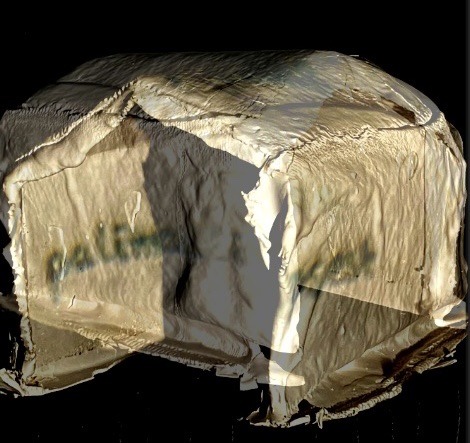



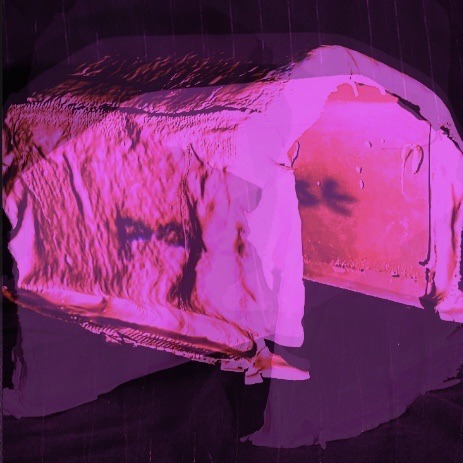
Images made by layering my photos of my plaster house with words projected onto it inspired by Idris Khan’s series Every... Bernd And Hilla Becher...
6 notes
·
View notes
Text
از وایمار تا دوسلدورف: دربارهٔ عکاسی عینیتگرای آلمان
From Weimar to Düsseldorf: Objective Photography in Germany
2020, First Print; 2022, Second Print
Published by Elm Publication
ISBN 978-622-246-031-0
The timeline of the book mostly voyages the German projects and movements that are described under the term, objective photography. Following this path, the first chapter begins by investigating the cultural aspects of the 19th century and the place of documentary photography as a revolutionary phenomenon. In this regard, the text discusses the contribu-tions of Francis Frith, David Octavius Hill, Robert Adamson, and Édouard Baldus. Furthermore, it focuses on the boundaries between objectivity and realism. A quality that shapes the distinction between realistic and romantic approaches in the last years of the 19th century. By this foundation, the second chapter reviews the early signs of objective viewpoint in the works of August Sander and Ernst Friedrich. Here, it is argued that the achievements of two photographers in utilizing documentation as a form of representation have created an understructure for the manifestation of objective photography in the next century.
The third chapter contains the main argument of this book. It begins with explaining the Weimar golden age and discusses how art in the German art scene flourished under certain circumstances. The text also discusses the new wave of visual language in the second decade of the 20th century. The development of the photographic vision within the New Objectivity movement also has been mentioned. In this regard, there is an extended discussion on Albert Renger-Patzsch and Karl Blossfeldt's contributions; Including but not limited to the examination of the Die Welt ist schön book as a publication with historical importance. The next chapter provides a context for the place of the objectivity movement by exploring the similarities and differences between German objectivity and its American equivalent, Straight Photography. In this section, the works of Alfred Stieglitz, Paul Strand, and Edward Weston are reviewed.
The shadow of World War II caused a gap between the first and second half of the 20th century, which affected the photography traditions. In the progression of the explored timeline in the book, the achievement of German photography during the golden age of the Weimar Republic was continued by Bernd and Hilla Becher. The fifth chapter created the connection between the New Objectivity movement and the conceptualism promoted by Bechers. This new understanding of photographic medium continued through The Düsseldorf School of Photography. To this end, the last chapter is dedicat-ed to exploring the works of Andreas Gursky. In this section, the text studies the edges of Gursky's subjective vision and his use of visual and spatial manipulation in photography. The con-nection between the meaning of his works and post-industrial culture is also discussed.
0 notes
Text

Mike Kelley, ArtistCraft Morphology Flow Chart , 1991
Medium
Mixed-media installation: dolls and figures, gelatin silver prints, acrylic on paper, folding banquet tables, folding card tables
Dimensions
Dimensions variable
Credit Line
Collection Museum of Contemporary Art Chicago Gift of Lannan Foundation, 1997.41. Photo: Nathan Keay, © MCA Chicago
Mike Kelley arranged these found, handmade figures in much the way that specimens would be ordered in a laboratory or displayed in a natural history museum, highlighting the museum's role of collecting, preserving, and displaying. By using a prescribed framework to organize cast-off personal artifacts, Kelley reveals the cataloging of objects as a portrait of vested interests and cultural mores. Black-and-white photographs of some of the figures hang on adjacent walls, reminiscent of both mug shots and typological photographic projects like those of the German photographers August Sander and Bernd and Hilla Becher. Even when Kelley used a clear system for grouping types of toys (as with the table of sock monkeys), each object is markedly different from the next, revealing the limits of the makers' skill and their aesthetic and cultural biases. What may previously have seemed like a simple toy becomes a marker of social context and exchange.
0 notes
Text
Object/Place Research Task
Photographer Notes
Edward Burtynsky
Canadian Contemporary Landscape Photographer that usually shoots in large format (8x10) that deals with the impact human intervention has had on the natural environment
Large scale landscapes that show loads of detail, very immersive and surreal to look at
Project "water" deals particularly with different man-made water systems
Chris Leslie
Accomplished photographer and filmmaker that has documented stories from around the world
Particular recognition for work documenting the disappearing landscape of Glasgow due to mass demolition in 60s and 70s.
people in poverty moved into new high rise flats in an attempt to improve their quality of life - captures difference in time comparing utopian solution to poverty to them now where they aren't taken care of and rotting away
Challenges: access to the buildings (people may not want their privacy being invaded by a photographer), safety concerns due to old buildings not being structurally sound
Mandy Barker
Deals specifically with global warming and pollution issue of marine plastic and has a very extensive body of work
reaches out to communities in order to get the vast amounts of waste she shoots for her projects
shoots a lot in studio and composite her images together
"Penalty" project is a double entendre and refers to both the literal subject of football and the world cup which the footballs are associated with but also the consequences that they are having on the environment
Andy Hughes
Another photographer that deals with the subject of marine plastic and trash, particularly washed up trash on beaches and coastlines (intertidal zone)
"Dominant Wave Theory" marked a significant milestone as one of the pioneering photographic monographs specifically focused on the subject of plastic pollution.
Challenges: possibly making the plastic look aesthetically pleasing like he does in his photos, may have to cover large areas looking for a specific item
Andy vs Mandy
Mandy shoots in the studio the composites her images together, where as Andy shoots on location using various additional lighting, especially overpower flash to create moody dynamic images - two very different styles and approaching the same items
Andy thinks more about scale and uses depth of field creatively and his backgrounds are important in his images
Mandy combines scientific facts within her work
Bernd & Hilla Becher
German photography duo that documented disappearing architecture across north America and Europe over the course of 40 years. Structures usually included various water tanks
Typologies with repeating composition, shooting angle and exposure allowed differences between the structures to be easily seen - fair comparison
When lined up next to each other, its like their own individualities shine through
2. Expanded Analysis of Photographers
Hiroshi Sugimoto
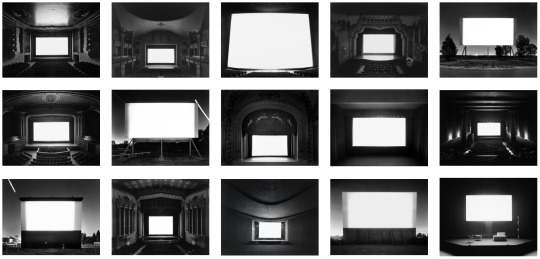
Sugimoto is a Japanese photographer and architect. He often combines his knowledge of structure and form of buildings and spaces from his architect background into his images as they are very well composed, clean and lined up. He also experiments a lot with different camera techniques and the optical effects these have on his images - such as long exposure. This is certainly true of his "theaters" series, a typology-type project he began in the late 70s where he would showcase many different classic American movie theatres built in the 1920s-30s using a large format camera on a very long exposure, using only the light of the projection as a lightsource. The results in very surreal, almost chilling photographs. His master use of light and long exposure (representing time) in perfect unison is symbolic of time passing and the effect it has had on these outdated forms of entertainment as modern culture had been growing and evolving.
Michael Wolf
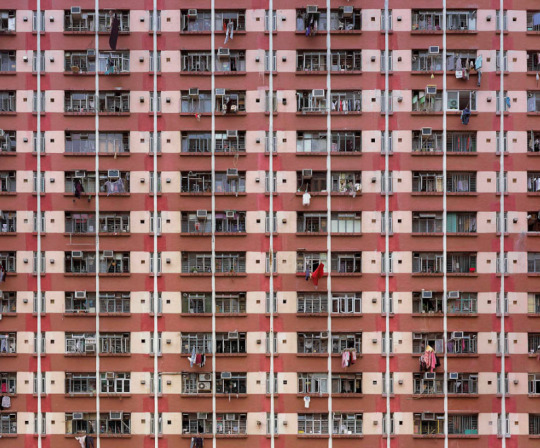
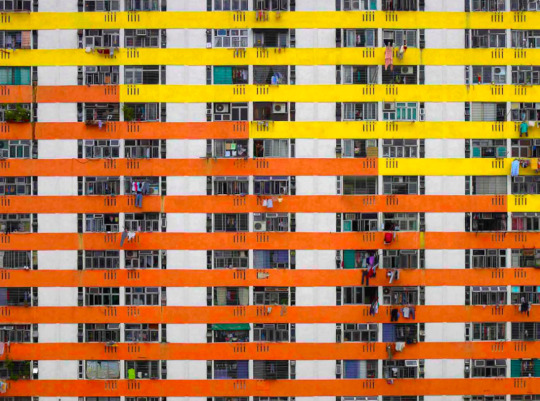

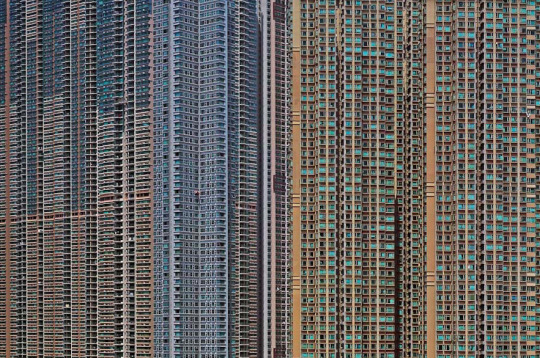
Wolf is a German-born photographer and photojournalist. His work focuses largely on contemporary city living, especially in densely populated asian countries. This overcrowding of the cities he works in has become a main focus behind his work and how he approaches his subjects (being buildings and complexes) in order to highlight this. This is particularly evident in his series of images called "Architecture of Density" - which was taken in Hong Kong and published in the form of a book in 2012. The photographer expertly captures the spatial experience of the city's inhabitants by removing any sky from the frame and flattening the space until it becomes more like a series of patterns rather than a building. This results in a feeling of endlessness in terms of size which is an amazing way of visually demonstrating the sheer scale of overpopulation happening in Hong Kong.
0 notes
Text
Wolfgang Tillmans:
Still lifes are metonyms made of talismans. They are a way to talk about something else. The Dutch, for example, used tulips and snails to craft compact allegories for commerce, trade, and the transience of life.
What makes this scene convincing, as all Tillman's scenes are, is that it's caught in the act. The parts just happen to be there - maybe only for a brief moment... Tillman's work feels emphatically not constructed; the idea is that he was lucky enough to see it.
His pictures are the opposite of Christopher Williams's adamantine photographs, which include the specifics of their construction in their titles, and they oppose, too, much other art photography, especially German photography, which prides itself on a black-and-white objectivity. Think of August Sandler's twentieth-century people; Bern and Hilla Becher's grids of gas tanks and cooling towers; Thomas Struth's streetscapes. Note how in the latter two bodies of work, human beings never appear. And in Sander's work, people are less individuals than types. Tilmann's work, by contract, is deeply peopled in both subject matter and point of view. Walead Beshty insists that it shares "the greatest affinity with the hybridized cinematic practices of Hollis Frampton, Morgan Fisher, Chris Marker, and Yvonne Rainer, each of whom wove together found images, quasi-autobiographical narration, and materialist abstraction into a materially based subjectivity.
Tilmann's photographs, while possessing a distinctive look, generate their power through accumulation, through their connections to one another, through something like a narrative or a concatenation of events. But how does narrative emerge from discrete pictures? Installation and display certainly play a part, but over time, the viewer also notices some force behind the camera. The photographs emanate from a body, some mostly absent center.
Though Tilmanns has long resisted the framing of his project as autobiographica, the best description for his work may be "autofiction," that genre in which the artist imagines alternate realities through the versioning of herself. Start with what's in front of you and go out from there. Photography is particularly well suited to this task: it is almost unable to resist the meshing of self and world.
0 notes
Text
Papa Stour Island I
Monday 3rd July
At 9 this morning I took the 40 minute ferry crossing to Papa Stour. There was just one other vehicle on the boat which can take six vehicles.
Like many of Shetland's islands, Papa Stour shows signs of life dating back centuries. Missionary Celtic priests settled here in the 6th century, although the island was first populated around 3000BC.
Suspected leprosy sufferers from the Shetland Mainland were once banished to huts, the foundations of which you can see on Hilla Fielle. To survive, they relied on islanders to leave food for them by the hill dyke.
It was part of Norway until the 1500s.
At its peak, Papa's population was around 380 in the 19th century, when a fishing station was opened at West Voe.
These days just 5 of the island’s 12 houses have permanent residents, the others are holiday rentals. Of the occupied 5, only 2 were at home this morning, and none of the rentals were occupied.
The island is popular with kayakers and divers (there are numerous shipwrecks close to the coastline). From the pier, the island has one road, of just over a mile.
It does however, have an excellent internet service, as it has been the ‘guinea-pig’ test case for remote settlements, with 5G over half the island, and fibre optic high speed broadband to all the properties.
On arrival, I received this message from my phone provider.. “Hi from EE. Welcome to Norway. While you’re here costs include..”
Something, I must admit, I hadn’t realised..

The ferry cross twice a day on Mondays, Wednesdays, Fridays, Saturdays and Sundays. I chatted with the crew on the way over, both had plans to build campervans and wanted to ask questions and take photographs of mine. They related some brief stories of rough seas, and we spoke about Norway, with Orkney in the news this morning, with the rumour of it changing its allegiance. The captain told me that Shetland were ahead of Orkney in the Norway queue. Shetland is 170 km from the Scottish mainland and 220 km from the Norwegian mainland. The piers I used, at West Burrafirth and on Papa Stour were both built with EU money. On the outlying Shetland islands from the Mainland, the project of rebuilding crumbling piers was only half way through on the UKs departure, and now is on hold.

I’m breaking the 23 miles track around the perimeter of the island into 3 days, and today we took on the spectacular north east peninsula, about 7 miles. The weather has settled from the rain of Saturday, but is much cooler now at 11C, cloudy and with showers.


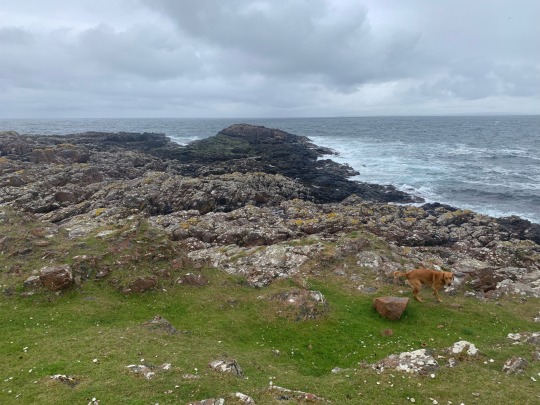
There are some good names to the various bits of headland. Willie’s Taing. The Creed. Robie’s Noust. Jerome Coutts’s Head.

I’ve written before about local names of places in the hills around where I used to live in the Lake District, and how a name is initially just used verbally by locals, often a nickname, and then over the course of many years, sneaks onto OS map.
It’s a legacy of a type, in Jerome Coutts’s case for sure.
Times change though, and these days I consider part of my legacy to be the many segments of routes that I give names to on the GPS tracking app, Strava. Mine are recognisable from in influences and interests, to anyone who knows me, Dylan lyrics, Python or Peter Cook quotes, favourite lines from books..


At Robie’s Noust we paused for a while to watch the grey seals in a calm bit of ocean. There were about six, diving, re-emerging and generally showing off and being curious.

And, a bit of video from the far northeast corner, and, on quite a calm day..
We were back at the van parked by the pier just as the ferry arrived for its afternoon collection. There were a couple of Austrian women, and a couple of bird-watchers who had come over on foot with me this morning. It had rained on and off during the morning, so they had limited their wanderings. Between ferry times, visitors have five hours, time enough to get to the rugged coasts on the far sides of the island.
A peaceful afternoon ensued, with a modicum of reading, a podcast, and a smidgeon of business.
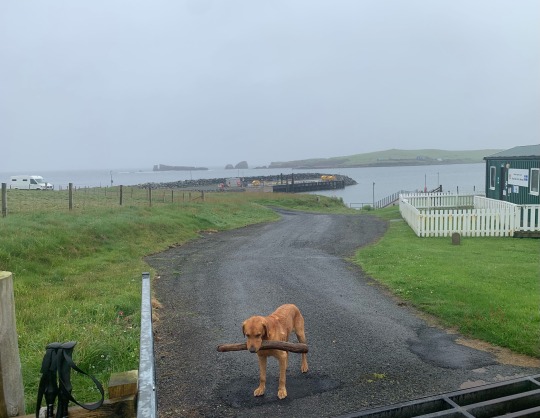
0 notes
Text



The Türme project is inspired by the architecture of water towers commonly found along roadsides. The designs of these towers vary widely in their shapes; conical, cylindrical, straight and narrow, wide, etc. As part of the visual research, we highlight the typological work of German photographers Hilla and Bernd Becher. Some of the following towers served as direct reference for the design of our objects.
Photos taken from the book Typologien industrieller Bauten by Bernd Becher and Hilla Beche. Edited by Schirmer/Mosela and published by Kunstsammlung Nordrhein-Westfalen in 2003.
0 notes
Text
2. part 1/2. Contextually reference your subject matter. What art, design, cultural, and historic references can you look at to gain insight? Describe them and why they are relevant.
The first reference is Bernd and Hilla Becher who were photographers who took pictures of the disappearing industrial architecture of Western Europe and North America that was fueling the modern era, the pictures that they took are very fascinating because all of the buildings were from the early 20th century and so looking at these images is history. The industrial architecture was very much thrown together with efficiency in mind not caring about the views and opinions of the population. It was all based on time and money. Chemical factories, water towers and cooling towers were some of the subjects that they photographed. Just looking at these images makes me think about how they would be perceived today and how soon they would be torn down. I think it's very interesting the way that design has now changed completely in terms of its market, now people have a massive impact on whether a design stays or goes.
A designer I like a lot is Max Lamb. His research into ways of working is to get your hands on the materials and test them in as many ways as possible, this relates a lot to the smithereens brief which I enjoyed very much. Linking to my chosen subject of effective/efficient, max lamb discovers his outcomes after he has tested the material to its max and found its most effective ways of being used. For a material to be its most efficient requires you to listen to it through testing, many people take materials out of their comfort zone Sometimes this can work however it might will feel unnatural and temporary. The cardboard chairs he made using Samsung packaging are simply designed so that people with limited skills could similarly replicate the design at home. The environment is a crucial aspect of contemporary designers' work and for a design to become successful it must be suited to today's society/climate. We are all very conscious of the environment, for example, many people mention "we don't need to be making any more plastic". This idea of using what we have available is something that recently I have been very much interested in. I'm fascinated/ annoyed by waste and what people are calling rubbish, the materials that end up in skips are shocking. A few of my projects have incorporated waste materials as I believe it's important to sometimes use damaged objects/materials in your work.
A project I have looked over many times is the 100 Chairs in 100 days and it's 100 ways by Martino Gamper. Martino's chairs maintain the main form of broken objects/ missing parts and add small/ large additions to create seating, this is a simple/ affordable way of using waste but it can be very difficult to create a new voice when a lot of waste materials already carry context. Martino Gamper incorporated well-known pieces by celebrated designers with items found on the road or in a skip. Through continuous testing, waste materials can become something of value.
0 notes
Photo

“If we can create portraits of subjects that are true, we thereby in effect create a mirror of the times.” - - August Sander If you were to take a portrait of every “type” of person that exists today, how many portraits would you need to take? If you grouped all of the portraits together into a series, what would it look like? How would you define and categorize these “types”? Where would you start? German photographer August Sander was likely considering these questions in the mid-1920s, when he began his decades-long project People of the Twentieth Century. “The individual does not make the history of his time, but he both impresses himself on it and expresses its meaning,” Sander explained. “It is possible to record the historical physiognomic image of a whole generation and—with enough knowledge of physiognomy—to make that image speak in photographs.” Sander’s work continues to be a source of inspiration for generations of photographers, including Walker Evans, Diane Arbus, Bernd and Hilla Becher, and Rineke Dijkstra. (at MoMA The Museum of Modern Art) https://www.instagram.com/p/Co45OOaLXFs/?igshid=NGJjMDIxMWI=
0 notes
Text
Major Project
- Industrialism Photographers
‘Photography, too, contributed to the artistic effort to make sense of the novelty of mass production. Indeed, this period saw the making of some of the most powerful visual images of industrial life ever created.’
Hilla and Bernd Becher
German photographers Hilla and Bernd Becher, influenced by typography studies found comparable between type and architecture and documented their travels around the UK and Whales through collections of photographs.
‘Industrial structures including water towers, coal bunkers, gas tanks and factories. Their work had a documentary style as their images were always taken in black and white. Their photographs never included people.They exhibited their work in sets or typologies, grouping of several photographs of the same type of structure. The are well known for presenting their images in grid formations.’
‘We photographed water towers and furnaces because they are honest. They are functional, and they reflect what they do - that is what we liked. A person always is what s/he wants to be, never what s/he is. Even an animals usually plays a role in front of the camera.’
https://www.artsy.net/article/artsy-editorial-photographer-couple-turned-industrial-architecture-fine-art
https://www.tate.org.uk/art/artists/bernd-becher-and-hilla-becher-718/who-are-bechers
https://www.metmuseum.org/exhibitions/becher
Hilla and Bernd Becher’s Photography




Charles Sheeler
Charles Sheeler was an American artist known for his Precisionist paintings, commercial photography, and the avant-garde film, Manhatta.
‘Sheeler was fascinated by photography’s precision, a quality that he called its “exactness” that work in watercolor or pencil found ever elusive. He also found that when industrial design was his subject, black and white photography allowed him to easily move from representation to abstraction.’
‘Sheeler noted, from the mundane everyday view to striking art, is part of the enduring magic of photography. In the realm of industry, it is magic indeed to take the noise and grime of the modern factory and create something of beauty.’
https://readframes.com/fordism-and-the-golden-age-of-industrial-photography-in-america-by-rick-halpern/
https://www.metmuseum.org/toah/hd/shee/hd_shee.htm
Charles Sheeler’s Photography

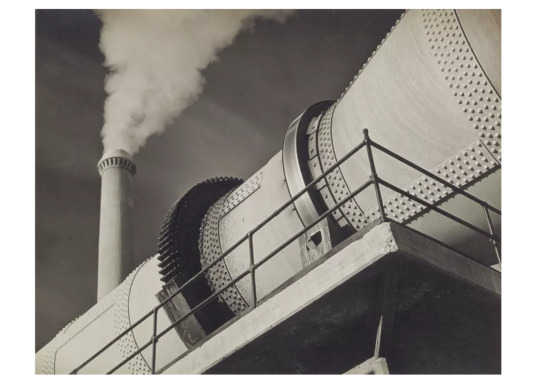

Frank Gilbreth
Frank Gilbreth, an American engineer who created the first light painting image, his photography was a lot different to others who shared the same interest in industrial machines Gilbreth was focused on exploring the extensions of these machines or his idea of their lesser parts, being people. His purpose was to capture and then to analyse the efficiency and productive capacity of industrial workers.
‘Gilbreth’s photographs treat workers as little more than machines, or cogs in larger machines; they appear in his images as not as full human beings but only as abstract representations of labor – an effect visually heightened in most of the photos by the blurred faces and arms produced by long exposure. Interestingly, many of the images used by corporations to promote themselves and document new technologies either pushed workers outside the frame or rendered them as extensions of machines.’
https://designobserver.com/feature/exposure-motion-efficiency-study-by-frank-gilbreth/39272
https://lucian.uchicago.edu/blogs/sciencefilm/human-sciences-on-film/human-movement-3/frank-gilbreth-films/
https://lightpaintingphotography.com/light-painting-photography/frank-gilbreth-work-study-videos/#:~:text=Frank%20Gilbreth%20was%20the%20first,camera%20to%20trace%20their%20movements.
https://we-make-money-not-art.com/the_chronocyclegraph/
Frank Gilbreth photography


Alfred Stieglitz
Alfred Stieglitz was an American photographer and modern art promoter who was instrumental over his 50-year career in making photography an accepted art form.
‘As the editor of Camera Notes, the journal of the Camera Club of New York—an association of amateur photography enthusiasts—Stieglitz espoused his belief in the aesthetic potential of the medium and published work by photographers who shared his conviction.’
https://www.metmuseum.org/toah/hd/stgp/hd_stgp.htm
https://www.vam.ac.uk/articles/alfred-stieglitz-pioneer-of-modern-photography#slideshow=4285889&slide=0
Alfred Stieglitz photography



Lewis Hine
Lewis Wickes Hine was an American sociologist and muckraker photographer. His photographs were instrumental in bringing about the passage of the first child labor laws in the United States.
‘Hine traveled throughout the eastern half of the United States, gathering appalling pictures of exploited children and the slums in which they lived.’
‘After his return to New York City, Hine was hired to record the construction of the Empire State Building, then the tallest building in the world.’
https://www.britannica.com/biography/Lewis-W-Hine
https://iphf.org/inductees/lewis-hine/
https://www.icp.org/browse/archive/constituents/lewis-wickes-hine?all/all/all/all/0
Lewis Hine photography


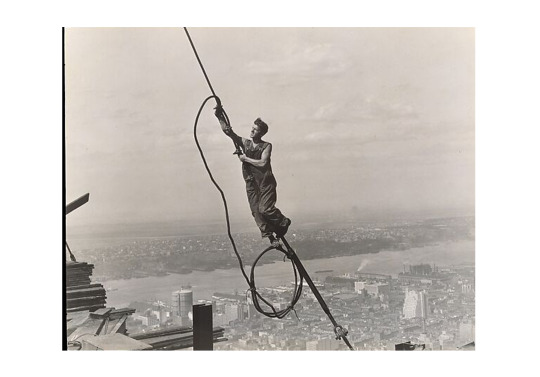

Other Unknown Photographers


0 notes
Photo
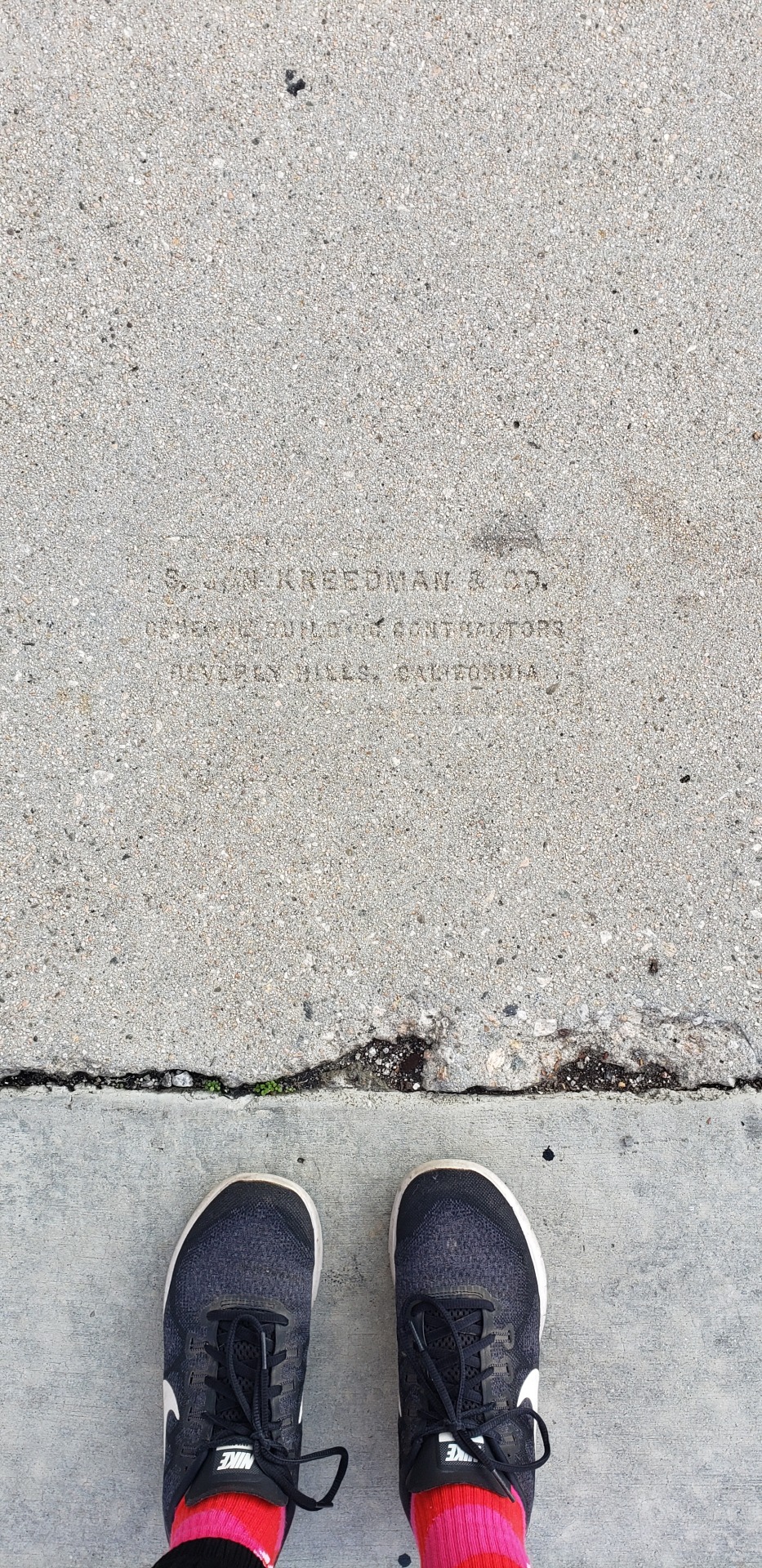
S. JON KREEDMAN & CO. (Photo taken by me in Beverly Hills on December 28, 2022).
Kreedman was born in 1921. He was “a carpenter from Detroit who had become a major developer in Southern California. [He] had learned construction as a teenager from his father and settled in Los Angeles” in 1941 (Pawel, Miriam. The Browns of California: The Family Dynasty that Transformed a State and Shaped a Nation, Bloomsbury Publishing USA, 2018). Before serving in the military during World War II, he built homes for a year and after worked his way up in the trade, starting S. Jon Kreedman & Co. in 1948 and registering their articles of incorporation on April 1, 1948, the corporation being inactive currently. Their address was 9601 Wilshire Blvd., Rm. #340, Beverly Hills, CA 90210. Kreedman was the President and James P Garity was the ‘Agent’ (bizstanding.com).
According to J. Marx Ayres’s autobiography, Kreedman “started with small office buildings and grew into developing large buildings along Wilshire Blvd.” Ayres worked with Kreedman as a mechanical engineer “on six high-rise office buildings including the 30-story ‘One Wilshire’ building at Grand Ave.” (Ayres, J. Marx. Red Diaper Baby Mid-Life Transitions: An Autobiography of J. Marx Ayres, 1946-2011, Trafford Publishing, 2012). He often purchased land for his projects and leased the units before he even began construction (Oliver, Myrna. ”S. Jon Kreedman; Real Estate Developer.” Los Angeles Times, November 8, 1999).
In 1956, he built a 171-unit complex, which were the first skyscraper apartments in Beverly Hills (LA Times).

In 1958, they were listed in a Directory of Arizona Contractors (Arizona Registrar of Contractors), though with their Beverly Hills, CA address of 9350 Wilshire Blvd., Suite 412, Beverly Hills, CA (17215). The above photo is of a drawing for a “six-story office building for Canon Drive and Clifton Way, Beverly Hills -- Two parking levels to be included in $750,000 concrete structure” from the Examiner, dated March 23, 1959 (USCLibraries).
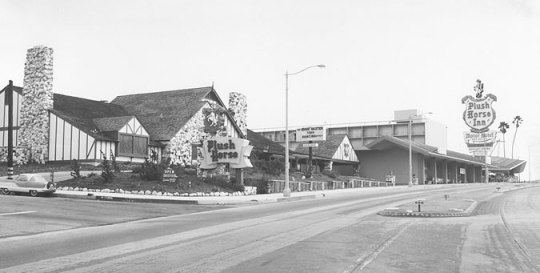
The following year, Fortune magazine named him one of the 100 largest builders in the country. He built 9171 Wilshire Blvd. in that same year, as listed in the City of Beverly Hills Planning Division Cultural Heritage Commission Report from 2019. He also worked on Redondo Beach, California’s Plush Horse Inn and Encino Medical Sqaure (no longer exists). The Plush Horse Inn has an interesting history which you can read about at the South Bay History blog. The building has been significantly remodeled as is now a branch of Bristol Farms since 2000.
Around the same time he worked on the Central Lanai & Carribean (sic) apartment complexes in Phoenix, Arizona. Undated records have him being involved with a six-unit apartment building at 442 S. Oakhurst Dr. in Beverly Hills, a 13-unit apartment building at 234 S. Hamilton Dr. in Beverly Hills, a 30-unit apartment building at 120 S. Crescent Dr. in Beverly Hills (by this is probably where I took the above photo), and a 16-unit apartment building at 5210 Romaine St. in Los Angeles. (Online Archive of California Finding Aid for the Samuel Reisbord papers, 1923-circa 1976.)
He was builder and owner of the 10-story United California Bank building at Camden Dr. and Wilshire Blvd. in Beverly Hills, CA in the early 1960s. There was a cave-in at the construction site, which Kreedman attributed to a broken water main (not sure how to cite a description of a photo but it’s from the description of order number 00103219 in TESSA Digital Collections of the Los Angeles Public Library).
In 1961, California’s Governor Pat Brown appointed him to the Advisory Commission on Housing Problems (Wikipedia).

By 1962, “he controlled US $50 million of real estate” (Wikipedia) and “Kreedman Realty & Construction Corp., 9350 Wilshire Blvd., Beverly Hilla, Calif., filed a regislration statement (File 2-20263) with the SEC seeking registration of $5,000,000 of convertible subordinated debentures due 1982 and 200,000 shares of common stock, to be offered for public sale in units consisting of $25 of debentures and one common share. A major portion of the net proceeds from this financing will be used to repay current indebtedness incurred or to be incurred in connection with the company's construction of the United California Bank Building, Beverly Hills, and the Crenshaw Medical Arts Centre, Los Angeles” (SEC News Digest, 04-20-1962).

He placed ads in the Directory of Members, Los Angeles County medical Association, 1961 and the California Yearbook, Volume 2, Issue 1, Democratic State Central Committee of California, 1963. Unfortunately, also in 1963, his wife, Thelma, filed for divorce claiming “extreme cruelty” (Independent, pg. 2, Long Beach, California, July 26, 1963).
From 1963-1983, Kreedman also served as chairman of the American City Bank, which he had also founded. It was the LA area’s largest independent bank at one time, with seven branches in Southern California (Wikipedia), but ended with Kreedman losing his initial investment when it was shut down by the State Banking Department for exhausting “its resources due to substantial loan and operating losses” and was acquired by United Overseas Bank (UPI Archives, February 25, 1983).
“In 1967, the Harvard Graduate School of Business Administration invited [him] to lecture on his entrepreneur role in helping to finance and build modern Southern California” (LA Times). According to Wikipedia, he had also been invited to give a lecture about the construction industry at UCLA in 1960.
In 1970, he refurbished the Alexandria Hotel (1905), which he had purchased in 1961, in downtown Los Angeles.
In 1973, his conversion of Century Towers to condominiums was one of the first in the city of Los Angeles and it’s largest luxury condominium property. Karen Carpenter purchased two of the condos and combined them into a duplex for herself in 1976 (The Century Towers - Wikipedia).
In 1979, Governor Jerry Brown appointed Kreedman to the board of directors of the state Public Employees Retirement System. By then, he was already known as a philanthropist “and supporter of Democratic political causes, having campaigned for the 1969 re-election of Mayor Sam Yorty in Los Angeles and serving as co-chairman of Brown’s 1973 campaign for CA governor. Kreedman’s charities included the Variety Club of Southern California and its work with handicapped and underprivileged children, Cedars-Sinai Medical Center, the City of Hope cancer research and treatment center, Hebrew University of Jerusalem and Israel Bonds Organization. He was also a board member of the Los Angeles city employees retirement system” (LA Times) and collected vintage cars (Wikipedia).
He died at age 78 after a long illness on November 5, 1999 in Los Angeles. He was survived by his wife, Marlene; daughter, Barbara; and a son, Dale (LA Times).

His wife was featured in the Beverly Hills Courier’s April 12, 2012 issue.
0 notes